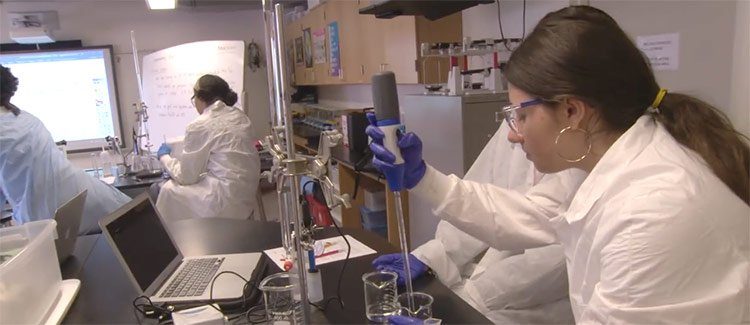Opportunities for rigorous coursework and extracurricular activities in high school do more than boost GPAs and add sparkle to students’ resumes. Students who take advanced classes are more likely to graduate high school, enroll in a four-year college, earn higher GPAs while there, and graduate in four years.
Whether high schools offer APs, IBs, dual enrollment, or high school honors classes, advanced courses offer more rigorous curriculums than standard high school courses do. While only some advanced courses result in college credit, those that do can also help students fulfill college requirements before leaving high school, potentially saving thousands of dollars on college tuition.
Opportunities for success
High schools with the best track records of preparing students for postsecondary success provide advanced academic offerings and academically challenging extracurriculars, and they make those opportunities for advanced learning widely available across the student body. These opportunities expose students to more intellectually rigorous material, helping them acquire the skills they need to succeed in college. They also demonstrate to college admissions officers that a student is motivated and ready for college-level work.
Ninety-nine percent of GreatSchools’ College Success Award-winning schools offer Advanced Placement (AP) or International Baccalaureate (IB) or other honors courses to their students (compared to 87% of non-winners). Award-winning schools also have a greater variety of AP courses, particularly in STEM subjects; award-winning schools are more likely than non-winners to offer AB and BC Calculus, AP Computer Science and Computer Science Principles, AP Statistics, AP Biology, AP Chemistry, AP Environmental Science, AP Physics (Electricity and Magnetism) and AP Physics (Mechanics).
Academically rigorous extracurriculars may also contribute to helping students become ready to succeed in college. College Success Award winners were far more likely to have intellectually challenging clubs like Chess, Mock Trial, Debate Team, Newspaper and Model UN than non-winners. The one exception was Robotics, the most commonly reported club of both winners and non-winners, which did not seem to be a differentiator for winners.
Allowing students access to advanced classes at earlier grades is key: 63% of award-winning schools allow 9th graders to take advanced courses and only 10% limit advanced-course enrollment to 11th and 12th graders; by contrast, only 49% of non-award-winning schools allow 9th graders access and 24% require students to wait until 11th grade or later to enroll in an advanced course.
College Success Award-winning Young Women’s Preparatory Academy offers an example that goes beyond just access. The single-gender 6th-12th grade magnet in Miami-Dade Unified School District automatically places every 9th grader in AP World History. With up to 24 AP classes available every year, advanced classes are not just accessible. They are the norm.
Also important is not imposing barriers to access to advanced classes, such as a GPA or a prior-class-grade requirement. Reducing financial barriers to advance courses is another factor in a high school’s success: 84% of award-winning schools offer financial assistance for AP and IB exams. Only 71% of non-award winners do the same.
Steps to greater equity: increase access and support for struggling students
For students from low-income backgrounds, the benefits of completing college credit-bearing coursework in high school are particularly pronounced: “Research suggests that students who complete AP and dual enrollment coursework are more likely than their peers to finish high school, enroll in a postsecondary institution, and complete a postsecondary credential or degree,” said Jennifer Zinth, director of high school and STEM initiatives for the Education Commission of the States.
However, students from low-income and marginalized backgrounds are less likely to enroll in advanced classes. GreatSchools’ 2018 College Success Award survey found a minority of both award-winning and non-award-winning schools reported enrolling a representative number of students from all ethnicities.
While reducing prerequisites may help make enrollment in advanced courses more representative of a school’s population, more work needs to be done to support all students in those classes. In response to a national trend to broaden participation in APs, Walter Parker, a professor of social studies education at the University of Washington, has focused his recent research on how to make AP government courses more relevant for students who have not traditionally enrolled in advanced classes. Increasing enrollment, Parker said, is just the first step towards helping more students benefit: schools must also provide essential supports so that the students who gain access to advanced courses will succeed.
“We know from College Board data that when you lower the threshold for entry you do get higher participation, but you also get higher failure rates,” Parker said. “So, the trick is to open up the enrollment but also to do something in the courses to increase students’ success.” Through his research, Parker has found that interactive in-class simulations can bolster engagement and help students succeed.
Additional steps schools can take
To further enhance students’ success, Zinth recommends a strategic approach:
- Schools can work with parents and students to identify courses that will result in college credit at students’ targeted postsecondary programs. About half of all states have policies on awarding AP credit.
- When offering APs, schools should also ensure adequate teacher training in AP subject areas. “If teachers do not have the content knowledge or understanding of the AP syllabus [and] exam to help students succeed on the AP exam, AP course participation, as broad as a school may wish to make it, is of limited value,” Zinth said.
- If a high school can only offer a limited number of AP courses, Zinth suggests they choose classes that will most likely fulfill general education requirements at state and regional postsecondary schools, to give students a leg up and more incentive to enroll in college.
- Finally, schools, districts, and states need to make sure that cost does not prevent low-income students from taking AP or IB exams. Many College Success Award-winning schools recognized that need: 84 percent of award schools offered financial assistance on exams, compared to 71 percent of non-award schools.
This article is part of a series exploring best-practice approaches used by recipients of GreatSchools’ College Success Award. The College Success Award honors public high schools in nine states that are doing a great job of preparing students for postsecondary success. Learn more about the award, see the list of winners, and read about more best practices here.






